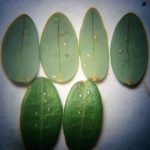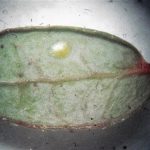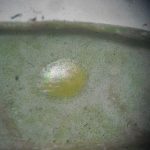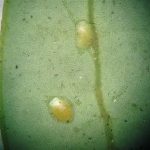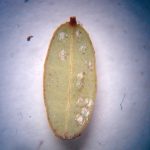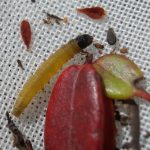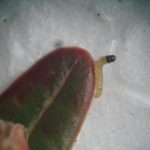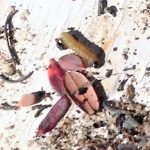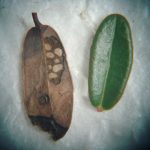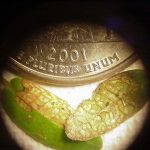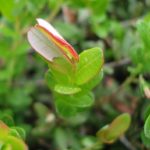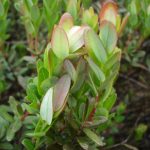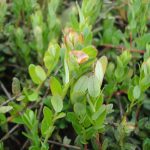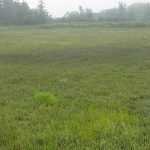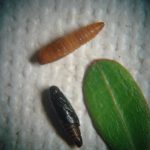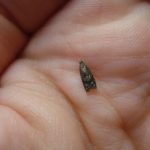- Blackheaded fireworm eggs on cranberry leaves (ordinarily any leaves on uprights growing on a bog with a fireworm infestation would typically have no more than just one or two eggs per ‘chosen’ leaf, but the moths that deposited these eggs were held in captivity with very few leaves at their disposal)
- Blackheaded fireworm egg on the underside of a cranberry leaf
- Closer view of the Blackheaded fireworm egg shown in the adjacent (left) photo
- A pair of Blackheaded fireworm eggs on the underside of a cranberry leaf
- Three hatched/empty blackheaded fireworm eggs
- Empty Blackheaded fireworm eggs on the underside of a cranberry leaf (7/20/16); the moth that deposited the eggs was in captivity with only a few cranberry stems at her disposal.
- Blackheaded fireworm larva (full-sized; final instar)
- Blackheaded fireworm larva
- A 1st-generation blackheaded fireworm larva, downeast Maine – June 17th, 2019. Look for the shiny black head to help with identification.
- Cranberry leaves damaged by Blackheaded fireworm larvae (they feed by skeletonizing the leaves)
- A fireworm-damaged cranberry leaf (left) next to an undamaged cranberry leaf (right)
- Two cranberry leaves with feeding injury from Blackheaded fireworm larvae
- A cranberry tip occupied by a Blackheaded fireworm larva (in Maine, be watchful for this in June each year)
- Cranberry tips pulled/webbed together and occupied by a Blackheaded fireworm larva
- Another example of some cranberry tips pulled and webbed together by a Blackheaded fireworm larva (some frass is also visible in this picture: little black droppings that are visible on the lower leaves)
- Another cranberry tip damaged by a Blackheaded fireworm larva hidden between the leaves
- A cranberry bed with a noticeable dark area that was ravaged by Blackheaded fireworm larvae (2nd-generation larvae) (photographed August 20th – downeast Maine) (be watchful in July and August for the 2nd generation of larvae)
- A pair of Blackheaded fireworm pupae (photographed June 21st in central Maine)
- An empty Blackheaded fireworm pupa after the moth has broken out of it (2nd-generation; August 2025)
- Blackheaded fireworm adult/moth (they are quite small)
- A Blackheaded fireworm moth (picture taken June 22nd – central Maine)
